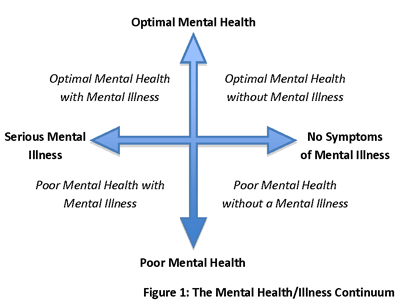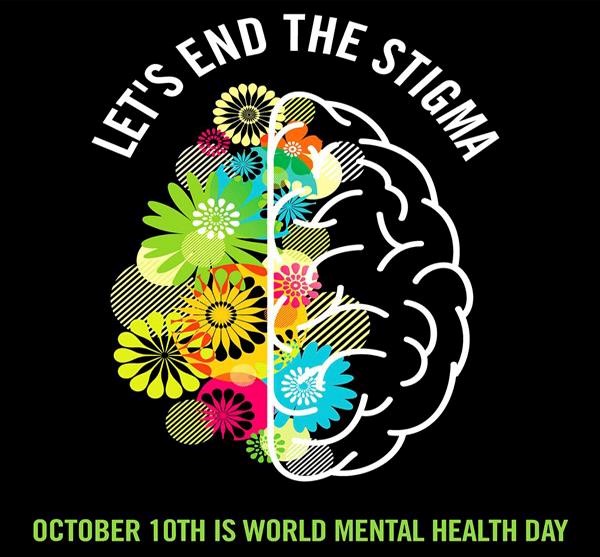18 Digging into Depression and Stigma
“I think it’s really important to take the stigma away from mental health… My brain and my heart are really important to me. I don’t know why I wouldn’t seek help to have those things be as healthy as my teeth.” — Kerry Washington, from HuffPost
Purpose:
To explore the lived experience of depression and unpack the stigma and shame associated with mental health challenges.
Learning Objectives
Participants will:
- Explore the continuum from mental health to mental illness.
- Discuss strategies for coping with depression.
- Examine ways our societies stigmatize people experiencing mental distress.
- Critically reflect on ways we have internalized rules and stories about mental illness.
- Reflect on ways of ending stigma.
Activity Directions
1. Reflection: Ask the participants to write the word “mental illness” in their learning journals and spend five minutes writing about what they think this term means and what images and thoughts come to mind when they think of mental illness.
2. Full Group Discussion: Can you share some of the thoughts and images that came to mind for you when you contemplated the term: Mental Ilness? What influences our concepts of mental illness? What differences are there in how we understand or view mental illness compared to physical illness? What do you think mental illness is? What are some of the reasons that you think there is stigma or shame about mental illness? Are there particular ways that your family, community or culture understands or treats mental illness or understands mental health?
3. We are all on a continuum. Put the following graphic on the screen and ask people for their interpretation of what this continuum means to them:

https://mentalhealth.csmls.org/
Key Takeaway Message
People can have a mental illness diagnosis, but have optimal mental health. This often means they have found treatments and self-management strategies that support them in being fully healthy and functioning. Conversely, some people do not have a mental illness, but are having personal challenges and possibly lifestyle issues that mean that they have poor mental health. Self-awareness, and if needed, professional assessment and treatment, can help anyone develop a plan to move towards their personal vision of optimal mental health.
For more indepth information about the continuum and mental health assessment tools: Check-Up from the Neck-Up
4. Case Study: “I Had a Black Dog and his Name Was Depression.”
Prepare the group, by telling them you want them to pretend that they are mental health counsellors and that the man in the video has come to them for help. Watch the video and stop at 2:19. Ask them to talk to the person closest to them. They have five minutes to list the behaviors, feelings and thoughts this man is experiencing and to brainstorm some things that might help him at this point.
5. Full Group Discussion: What were some of the symptoms of depression that this man was experiencing? How is depression different from sadness? If he came to talk to you as a friend, what might you do or say at this point? If you were a mental health counsellor what might you want to say or do to support this man?
6. Watch to the end of the video and discuss: Debrief participants’ reactions to the video.
- What strategies were helpful for this person?
- Is there anything else that has helped you when you have had a difficult health or mental health challenge to overcome?
- How do you feel about the dog as a metaphor for depression?
- In your culture or personal experience is there another animal or symbol that you would use to represent a mental health challenge?
- How does this approach to understanding depression fit with your experience or cultural understanding of mental illness and mental health?
7. Discuss STIGMA: In this video the man tries so hard to hide his “black dog” and pretend he is “normal”.
- Why are we ashamed of depression?
- What is stigma?
- How does it influence our decisions and health?
- Where do we learn to feel shame about mental health?
- How is stigma expressed and handled in your community or culture?
- What can we do to end “stigma?”
- What are you willing to do this week that de-stigmatizes depression and other mental health conditions?
Self-Stigma
Self-stigmas around mental health, as defined by the APA, are “the negative attitudes, including internalized shame, that people with mental illness have about their own condition.” What is mental health stigma and how do we end it
Stigma has been found to be a major barrier to people accessing to mental health care, as compared to physical health care. Here is a thorough description of the stages of stigmatization and how it creates a sense of “us” and “them” that influences people’s identity, wellbeing and health outcomes:
“Evidence suggests that stigma and discrimination undermine well-being related to mental health and substance use. Stigma
and discrimination represent judgemental attitudes and unjust reactions to diversity and the range of human experiences. Stigma develops through stages in which people are first labelled, based on a socially selected difference. The people labelled can then be devalued by linking the label to a negative stereotype leading to a clear separation of “us” from “them.” The result is status loss, discrimination and unequal outcomes.”Using Dialogue to Address Stigma, B.C. Mental Health and Substance Use Services
Facilitation Note: The quotation above is taken from a unit about stigma and the power of dialogue from the University of Victoria’s Substance Use Research Center. I highly recommend that facilitators read the full article before embarking on the following reflections and discussion about stigma. Depending on your participants, you might want to have the whole group read the article before discussing stigma in their families and communities. It is a sensitive exploration of this important topic and it also gives guidelines for creating trauma informed and meaningful conversations that illuminate and disempower stigma’s grip.
To engage in dialogue about difficult topics takes self-awareness, compassion and willingness to understand another’s experience and truth:
“We all have assumptions and make judgements. To engage in dialogue, we must first become aware of our own assumptions and judgements and be able to suspend them when we listen to others. When we allow our assumptions and judgemental attitudes to remain unexposed and go unchallenged, we may find ourselves engaging in discriminatory behaviours. Listening respectfully while suspending our own opinions can provide us with the space to maintain our equilibrium and not get impatiently excited or reactive.”
Using Dialogue to Address Stigma, B.C. Mental Health and Substance Use Services
8. Dig deeper into exploring the internalized stories and rules that our society has about mental health and mental illness. Facilitator says: “The next activity will help us gain more insight into how stigma impacts our individual behavior and how society operates. This activity will be done in 3 steps. First we would like you to work on the worksheets by yourself, then you will discuss in small groups, and then we will report back and debrief in a large group. We will take you through the steps one by one.”
- Hand-out the worksheet and give people 10 minutes to reflect and write about the rules and stories they have internalized about mental health and mental illness.
- Small group discussion: Divide into four small groups. Count off 1,2,3,4 around the circle and get into the small groups, the 1’s with the 1s, the 2’s with 2’s and so on. Discuss with your small group the stories, rules and attitudes that your family or community had around talking about mental health/mental illness. Are there gender or cultural differences? How did these stories impace behavior?
Hand-Out Worksheet (or can be posted and people write responses in their reflection journals )
| Rules/Stories about (e.g., Mental Health/ Mental Illness family and community) |
What these rules and stories lead to (e.g., how they affect behaviours and relationships) |
|
Personal/Family
Societal
|
Personal
Societal
|
Examples of stigma and personal and societal impacts.
9. Full group discussion: You have now spent time reflecting on stigma in your family and community and listened to the experiences of your group mates. What are some of your observations about how stigma shows itself in our lives and society? Does anyone want to describe a time they experienced or witnessed stigma? What ways have you stood up to stigma or tried to change a stigmatized view of mental health? What can we do to End Stigma?
Optional Assignment:
Public Service Project about Mental Health and Ending Stigma
Ask participants either individually or in small groups to design a poster, song, skit or short Tik Tok style video that explores STIGMA and ways to end the stigmatization of mental illness.
Their project should explain some aspect of mental health, ways of improving mental health or messages about ending the shame and stigma around mental health.
Have a sharing event where the creative outputs are promoted through social media or on walls or screens where the public can view them.
This is a great project for World Mental Health Day that takes place every October.

